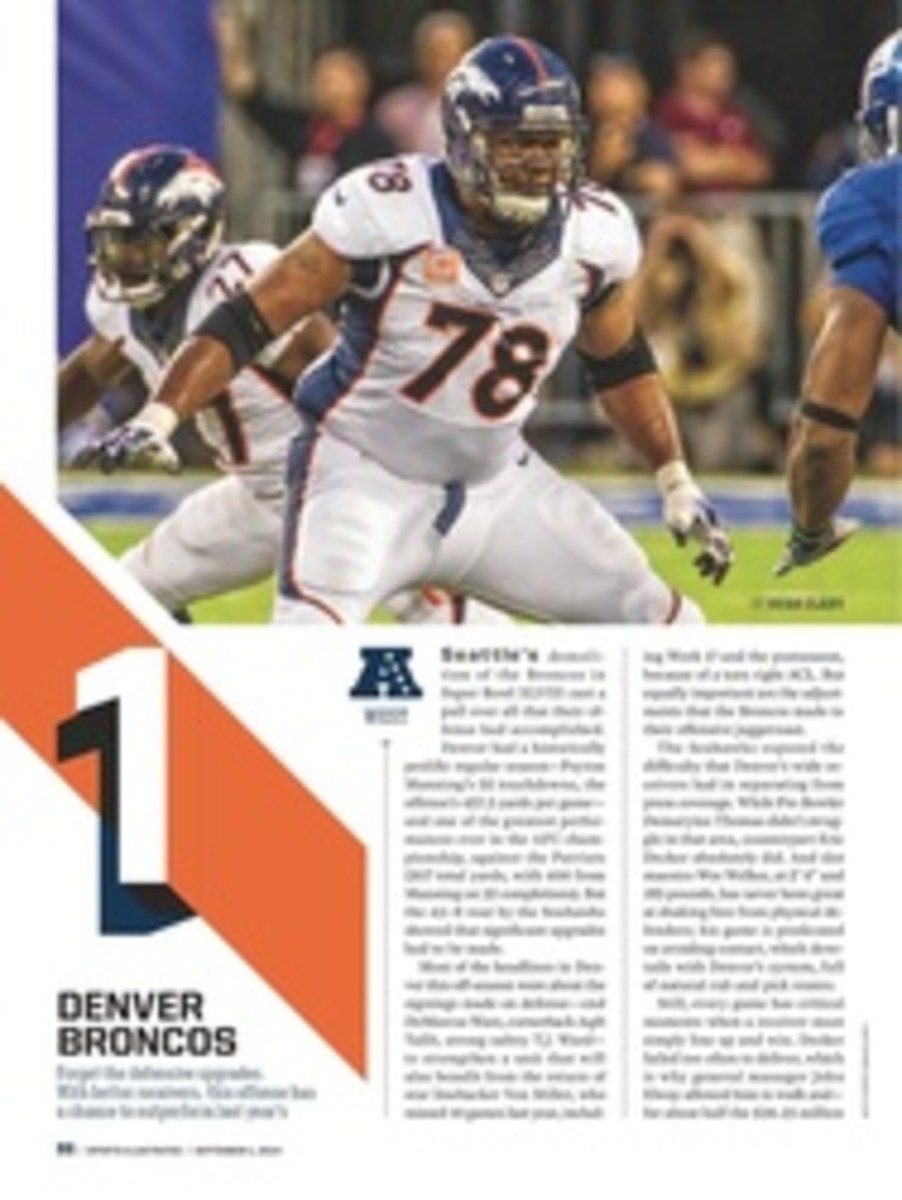
4 CAROLINA PANTHERS
It's not too hard identifying which teams are primed to take a step forward. The tougher task—the one that requires looking below the surface—is identifying the ones likely to take a step backward. Here, the key ingredients include losing veteran leaders, downgrading at important positions and displaying glaring weaknesses that have been patched over with still-developing players.
Carolina checks all three boxes. Left tackle Jordan Gross (retired) and receiver Steve Smith (cut), both reliable veterans, are gone. So is secondary leader Captain Munnerlyn, who signed with the Vikings. Along with Smith, Branden LaFell and Ted Ginn also exited, leaving a gaping pass-catching hole that general manager Dave Gettleman stop-gapped with free agents Jerricho Cotchery and Jason Avant, two thirtysomethings who, because of their limited speed, are merely possession targets. Gettleman also used his first-round draft pick on 6'5", 240-pound Kelvin Benjamin, a Plaxico Burress type who, after just one productive year at Florida State, is no guarantee to make an immediate impact.
In Gross's stead the Panthers will try their luck with the heavy-footed Byron Bell, who moves over from right tackle—which now becomes a position of concern. For Munnerlyn in the slot, they'll go with either converted safety Charles Godfrey (coming off an Achilles injury) or fifth-round rookie Bené Benwikere (San Jose State). Are you starting to see a pattern? Young, untested players, plugging holes.
On defense, that won't be as much of an issue; the fresh talent will have the support of ends Charles Johnson and Greg Hardy, as well as captain Luke Kuechly, who in his third season already carries the title of Best Linebacker in Football. Carolina finished second to the Seahawks in points allowed last year (15.1 per game) and did not give up a first-half touchdown until Week 9, a feat matched just once in the previous 78 years. This unit, however, will have to be even better in 2014 because the young leader of the Panthers' offense doesn't provide the sort of stability that Kuechly lends the defense.
Cam Newton's running prowess is top-notch, and his arm strength is unquestioned, but those traits aren't always enough to overcome poor mechanics and inconsistency in reading the field. Three seasons after being drafted No. 1, Newton has a bad tendency to stick with his initial option for too long and lose his sense of the play design. These flaws lead to an unreliable offense, which is trouble given Carolina's lack of pass-catching talent.
Because his receivers are unable to consistently create windows on their own, coordinator Mike Shula will have to get them open through play design. That calls for intertwined route combinations and defined progression reads for the quarterback, and it means that Newton has to play with better fundamentals and discipline than he's shown. It's also imperative that Newton be supported by a strong rushing attack. The Panthers have put up solid numbers on the ground in recent years, but a large chunk of that production has come from Newton's scrambling. In reality, this offense has not established a foundational, week-in-and-week-out ground game, and too many of its staple plays are based on gimmicky read-option concepts.
In fairness to Shula, those read-options do fit the personnel. With either DeAngelo Williams or a (hopefully) healthy Jonathan Stewart at tailback, bowling-ball runner Mike Tolbert at fullback and Newton handling the snap, Carolina's backfield boasts three formidable rushing threats that defenses must account for, and Shula does a commendable job of crafting multidimensional designs around them. Those plays, however, need to be supplemented with more basic ideas, what NFL play-callers refer to as "attitude" runs, such as dives, counters and powers.
A firmer rushing attack—which, from a blocker's viewpoint, is less about athleticism than it is about brute force—would alleviate pressure on an offensive line that, aside from four-time Pro Bowl center Ryan Kalil, is ill-equipped to survive on its own in pass protection. The hope: that improvements in the running game can offset losses in the passing attack.
That might be wishful thinking for a team that shows every sign of regression. But if the D can top what it did one year ago (no small order), Carolina will be in plenty of close battles. With shrewd, aggressive game management from coach Ron Rivera and a playmaker at quarterback, it's not impossible for this team to muster a few extra wins.
It just won't be easy.
2014 SCHEDULE
2013 Record: 12--4
WEEK 1
TB [AWAY]
DET [HOME]
PIT [HOME]
BAL [AWAY]
CHI [HOME]
CIN [AWAY]
GB [AWAY]
SEA [HOME]
NO THUR [HOME]
PHI MON [AWAY]
ATL [HOME]
BYE
MIN [AWAY]
NO [AWAY]
TB [HOME]
CLE [HOME]
ATL [AWAY]
WEEK 17
MAJOR CONCERN
The secondary
The Panthers don't have the defensive backfield to win in man coverage, so you can expect them to continue playing a fairly vanilla zone scheme—granted, one that mixes in selective blitzes. Unless talented but tentative free-agent pickup Antoine Cason (Cardinals) recaptures his form from several years ago, the cornerbacking unit will take a significant hit. Captain Munnerlyn, who signed with Minnesota, was Carolina's most impactful starter on the outside and its only capable man defender in the slot. The safety position is no less feeble. Falcons castoff Thomas DeCoud will be asked to patrol centerfield—something he's done with mixed results. In the box, former Saint Roman Harper can be a stout tackler and blitzer, but his vulnerability in coverage could lead to more snaps for Robert Lester, an undrafted second-year pro who's not immune to mistakes himself. The Panthers, in other words, will need their star-studded front seven to bolster a patchwork defensive backfield.
THE CASE FOR
Middle linebacker Luke Kuechly
In winning the Defensive Rookie of the Year (2012) and Defensive Player of the Year ('13) awards, Kuechly demonstrated a diagnostic ability that's off the charts, as well as speed and quickness. He identifies run plays before they unfold and attacks the line of scrimmage fast enough to prevent blockers from staying on double teams against Carolina's front four defenders. In short, Kuechly is the best middle linebacker in football, by far. It certainly helps that he has a strong cast around him. Leading the front four is fifth-year end Greg Hardy, whose combination of power and quickness—off the edge and inside—led to 15 sacks last season. On the opposite side Charles Johnson is a steady edge stopper who in recent years has developed pass-rushing skills at defensive tackle (which he often plays in nickel). Kony Ealy, a second-round rookie from Missouri, will further buttress the pass rush, alongside last year's first-round pick, Star Lotulelei, whose quickness off the snap makes him difficult to block one-on-one. And next to Kuechly is 10th-year man Thomas Davis, whose coverage acumen helps give Carolina the league's best nickel linebacking tandem. But as good as this front seven is, the Panthers' defense would fall apart without its superstar captain in the middle.
PHOTO
JED JACOBSOHN FOR SPORTS ILLUSTRATED
QB CAM NEWTON
PHOTO
STREETER LECKA/GETTY IMAGES
NINTEEN PHOTOS

